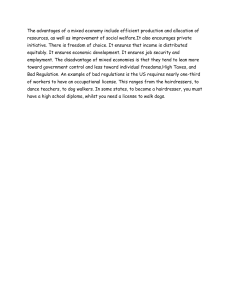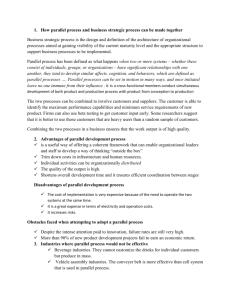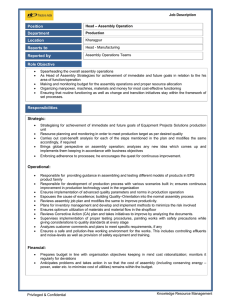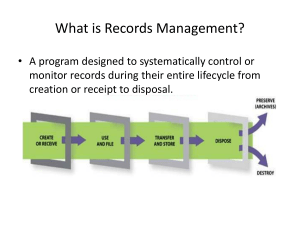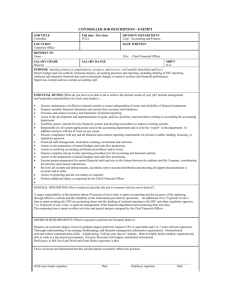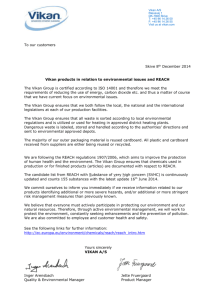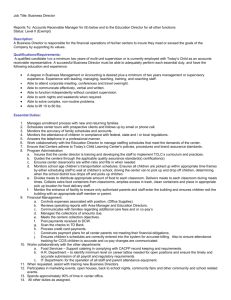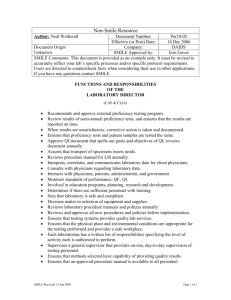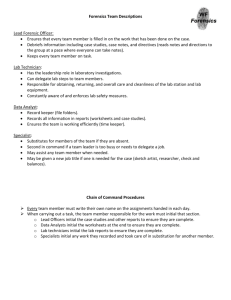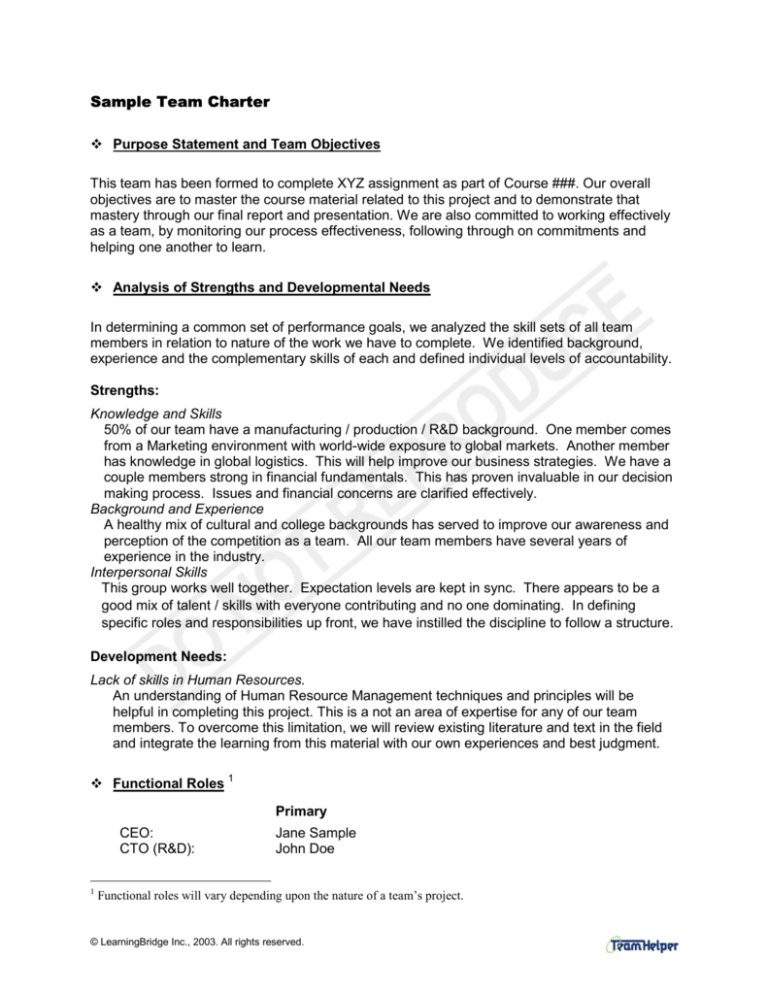
Sample Team Charter
! Purpose Statement and Team Objectives
This team has been formed to complete XYZ assignment as part of Course ###. Our overall
objectives are to master the course material related to this project and to demonstrate that
mastery through our final report and presentation. We are also committed to working effectively
as a team, by monitoring our process effectiveness, following through on commitments and
helping one another to learn.
! Analysis of Strengths and Developmental Needs
In determining a common set of performance goals, we analyzed the skill sets of all team
members in relation to nature of the work we have to complete. We identified background,
experience and the complementary skills of each and defined individual levels of accountability.
Strengths:
Knowledge and Skills
50% of our team have a manufacturing / production / R&D background. One member comes
from a Marketing environment with world-wide exposure to global markets. Another member
has knowledge in global logistics. This will help improve our business strategies. We have a
couple members strong in financial fundamentals. This has proven invaluable in our decision
making process. Issues and financial concerns are clarified effectively.
Background and Experience
A healthy mix of cultural and college backgrounds has served to improve our awareness and
perception of the competition as a team. All our team members have several years of
experience in the industry.
Interpersonal Skills
This group works well together. Expectation levels are kept in sync. There appears to be a
good mix of talent / skills with everyone contributing and no one dominating. In defining
specific roles and responsibilities up front, we have instilled the discipline to follow a structure.
Development Needs:
Lack of skills in Human Resources.
An understanding of Human Resource Management techniques and principles will be
helpful in completing this project. This is a not an area of expertise for any of our team
members. To overcome this limitation, we will review existing literature and text in the field
and integrate the learning from this material with our own experiences and best judgment.
! Functional Roles
1
Primary
CEO:
CTO (R&D):
1
Jane Sample
John Doe
Functional roles will vary depending upon the nature of a team’s project.
© LearningBridge Inc., 2003. All rights reserved.
Marketing:
Production:
Finance:
Labor Relations:
Mike Smith
Sally Jones
Alan West
Susan East
! Team Process Management
Team Meetings:
We begin each meeting with a SPACER (Safety, Purpose, Agenda, Code of Conduct,
Expectations).
• Safety: Awareness of exits in case of emergency.
• Purpose of meeting: Identify the purpose of the meeting. The team agrees on deliverables
for the meeting.
• Agenda: Identify the steps to be taken and topics to be discussed. The team generates and
agrees upon an agenda and allocates time per item.
• Code of Conduct:
" Arrive on time
" Stick to the agenda
" 3 knock rule if any team member deviates from the agenda
" One person speaks at a time
" No sidebars
• Expectations: Expectation levels are set at the beginning of every meeting.
Decision Making Procedure:
Solicit recommendations from the functional champion. Open discussion on the topic, soliciting
opinions from all members. Use facts to generate alternative solutions. At conclusion of the
discussion, allow for feedback on unresolved issues related to the topic. Go around the room
and ask each person for final comments. Look for consensus. (We define consensus as the
point where all team members can say “This may not be my ideal decision outcome, but I can
live with it and will support it.”)
Team Communication:
We will communicate with one another through various means. Electronic and phone
communication are the most widely used modes outside of meetings. Prompt responses to
messages/inquiries from one another are expected. If a member is unable to deliver as
promised, they should advise the group in advance so that alternate arrangements can be
made.
Process Roles:
Standard process roles for our Team are:
•
•
Team Leader - Ensures agenda is ready, guides team through meeting discussion topics,
ensures assignments are delegated, and summarizes key meeting outcomes and next
steps.
Process Monitor - Facilitates resolution of differences of opinion. Ensures team adheres to
meeting guidelines described earlier.
© LearningBridge Inc., 2003. All rights reserved.
•
•
Time Keeper – Keeps track of time in relation to agenda.
Recorder – Keeps minutes and records of key meeting outcomes and activities. Ensures
team correspondence is distributed to all team members
Additional roles are added if necessary. Roles are rotated at each meeting.
Expectations of Team Members:
Attendance at meetings
Attendance is expected for every meeting. If a member is absent, the secondary person fills in
the role. On-time arrival for the meetings is also expected.
Participation
Full participation is expected of all team members. If someone feels that others are not doing
their job, the concerned member will discuss it one-on-one, offline. If that doesn’t work, then the
member will bring it up with the team leader.
General Courtesy and Respect
Members will respect the different functional areas and the role of each member designated to
that function. An active rule is avoidance of the seven words that you can’t say on T.V.
Discussion that deviates from the current topic and objectives are considered avoidable. The
team leader will bring focus back to the topic at hand.
! Assessment of Team Effectiveness
We will conduct a post-mortem at the conclusion of every meeting. In this review we will: 1)
Assess our effectiveness in relation to our stated objectives (e.g. Did we meet our goals? Are
we where we need to be in order to complete our work on time? Do we have all the information
we need?); 2) Assess our effectiveness at working together (e.g. Are we living up to our
Process Management Guidelines?). We will also utilize the assessment tools available to us
such as Team Feedback Survey. We will make adjustments based upon our reviews and set
improvement goals to guide subsequent efforts.
© LearningBridge Inc., 2003. All rights reserved.


